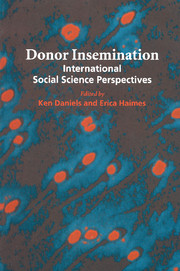Book contents
- Frontmatter
- Contents
- List of figures
- List of tables
- Notes on contributors
- Acknowledgements
- List of abbreviations
- 1 International social science perspectives on donor insemination: an introduction
- 2 The users of donor insemination
- 3 Families created through donor insemination
- 4 The making of ‘the DI child’: changing representations of people conceived through donor insemination
- 5 The semen providers
- 6 The medical management of donor insemination
- 7 Regulation of donor insemination
- 8 Donor insemination and ‘public opinion’
- 9 Concluding comments
- Index
2 - The users of donor insemination
Published online by Cambridge University Press: 04 August 2010
- Frontmatter
- Contents
- List of figures
- List of tables
- Notes on contributors
- Acknowledgements
- List of abbreviations
- 1 International social science perspectives on donor insemination: an introduction
- 2 The users of donor insemination
- 3 Families created through donor insemination
- 4 The making of ‘the DI child’: changing representations of people conceived through donor insemination
- 5 The semen providers
- 6 The medical management of donor insemination
- 7 Regulation of donor insemination
- 8 Donor insemination and ‘public opinion’
- 9 Concluding comments
- Index
Summary
Introduction
Donor insemination (DI) is the oldest, most widely used, and probably most effective alternative method of conception in use today. Yet its use continues to be fraught with anxieties, controversies, and a deep cloak of secrecy. Those who consider donor insemination often do so at first with great reluctance and with fears about the ramifications and the results. The focus of this chapter is on the concerns and experiences of those who are potential or actual users of DI. Donor insemination has two very distinct types of users, and these two groups have almost entirely different needs and priorities, different experiences and different dilemmas. Although most fertility programmes are geared exclusively or primarily to married couples, and in some countries they are limited by law to married couples, donor insemination is increasingly being used in many parts of the world by single women, both heterosexual and lesbian. Two important changes are pushing this trend: alternative treatments have become increasingly available that allow men with severe fertility impairments to father children, eliminating the need for a donor, and the idea of single motherhood through insemination has become more widely accepted. In addition, the possibility of finding ones own donor and carrying out the insemination at home eliminates for many single women the necessity of having to get past the barriers that exist to their using medical services (Stephenson and Wagner 1991).
- Type
- Chapter
- Information
- Donor InseminationInternational Social Science Perspectives, pp. 7 - 32Publisher: Cambridge University PressPrint publication year: 1998
- 6
- Cited by



